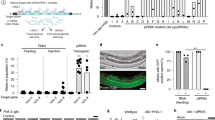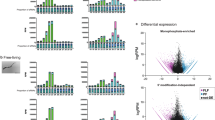Abstract
The introduction into cells of foreign nucleic acid molecules can induce sequence-specific gene silencing in some organisms. Here we show that two distantly related organisms, the nematode Caenorhabditis elegans and the fungus Neurospora crassa, which have quite different mechanisms of gene silencing, both use a similar protein to control the process. This suggests that they may share an ancestral mechanism that evolved to protect the genome against invasion by foreign DNA.
Similar content being viewed by others
Main
In homology-dependent gene silencing (HDGS), gene expression can be prevented by either DNA or RNA molecules. For example, double-stranded (ds) RNA can inhibit gene expression1 in C. elegans, Drosophila and Trypanosoma, and transgenic DNA can induce gene silencing in plants2 and fungi3.
In a process known as dsRNA interference, dsRNA silences the expression of endogenous C. elegans genes after they have been transcribed by inducing sequence-specific degradation of homologous messenger RNA molecules4, preventing their translation into protein. Plants and fungi also use post-transcriptional gene silencing (PTGS), but this is induced by transgenic DNA. Again, transcription of the target gene is unaffected but its transcripts do not accumulate as a consequence of rapid degradation.
There are several indications that RNA intermediates are involved even in transgene-induced gene silencing — transgenes produce RNA molecules known as aberrant RNAs, which somehow manage to induce messenger RNA degradation2. The two mechanisms of PTGS and dsRNA interference both involve sequence-specific degradation of homologous messenger RNA and an ability of silencing to spread from cell to cell.
Although HDGS phenomena have been considered to be related mechanistically and evolutionarily, no experimental evidence has been forthcoming to support this idea, principally because so far it has not been possible to compare the underlying genetic mechanisms. Genetic characterization of PTGS has been reported for Arabidopsis thaliana5 and N. crassa6, and mutants unable to perform dsRNA interference have been isolated from C. elegans7,8. These mutants should enable the different components of the cell's gene-silencing machinery to be identified. By comparing the sequences of the respective protein products, we have found that the qde-2 gene, which controls transgene-induced gene silencing in N. crassa6, is homologous to the rde-1 gene7, which is essential for dsRNA interference in C. elegans (Fig. 1).
This finding is, to our knowledge, the first experimental evidence indicating that dsRNA interference and PTGS induced by transgenic DNA share a common genetic mechanism. It supports the idea that HDGS phenomena evolved from an ancestral mechanism aimed to protect the genome against transposons and viruses. Our results also suggest that dsRNA molecules might participate in PTGS in fungi.
dsRNA could be produced directly from integrated transgenes as a result of the presence of inverted repeats, or as an outcome of transcription from convergent inverted promoters. Alternatively, transgenic single-stranded aberrant RNA may be used as a template by QDE1, a putative RNA-dependent RNA polymerase9, to produce dsRNAs. Further analysis should define the mechanistic function of rde-1 and qde-2 in gene silencing and confirm whether the homology between these two genes effectively corresponds to a cognate step in the two gene-silencing mechanisms.
As well as including rde-1, the qde-2 gene family has members in both plants and animals: in A. thaliana and Drosophila, qde-2 homologues have been implicated in the regulation of development10, and the rabbit qde-2 homologue, eIF2C, forms part of a protein complex that stimulates the start of translation11. As all the qde-2 homologues have not yet been biochemically characterized, it is possible that these evolutionarily related genes could be required for different biological processes.
References
Fire, A. Trends Genet. 15, 358–363 ( 1999).
Wassenegger, M. & Pelissier, T. Plant Mol. Biol. 37, 349–362 ( 1998).
Cogoni, C. & Macino, G. Trends Plant Sci. 2, 438–443 (1997).
Montgomery, M. K., Xu, S. & Fire, A. Proc. Natl Acad. Sci. USA 95, 15502– 15507 (1998).
Elmayan, T. et al. Plant Cell 10, 1747– 1758 (1998).
Cogoni, C. & Macino, G. Proc. Natl Acad. Sci. USA 94, 10233–10238 (1997).
Tabara, H. et al. Cell 99, 123–132 (1999).
Ketting, R. F., Haverkamp, T. H., van Luenen, H. G. & Plasterk, R. H. Cell 99, 133–141 ( 1999).
Cogoni, C. & Macino, G. Nature 399, 166–169 (1999).
Benfey, P. N. Curr. Biol. 9, 171–172 ( 1999).
Zou, C., Zhang, Z., Wu, S. & Osterman, J. C. Gene 211, 187–194 (1998).
Author information
Authors and Affiliations
Corresponding author
Rights and permissions
About this article
Cite this article
Catalanotto, C., Azzalin, G., Macino, G. et al. Gene silencing in worms and fungi. Nature 404, 245 (2000). https://doi.org/10.1038/35005169
Issue Date:
DOI: https://doi.org/10.1038/35005169
This article is cited by
-
Establishment of Neurospora crassa as a model organism for fungal virology
Nature Communications (2020)
-
Enzymatic construction of shRNA library from oligonucleotide library
Genes & Genomics (2019)
-
Genome editing approaches: manipulating of lovastatin and taxol synthesis of filamentous fungi by CRISPR/Cas9 system
Applied Microbiology and Biotechnology (2017)
-
The entangled history of animal and plant microRNAs
Functional & Integrative Genomics (2017)
-
Resistance of transgenic silkworm to BmNPV could be improved by silencing ie-1 and lef-1 genes
Gene Therapy (2014)
Comments
By submitting a comment you agree to abide by our Terms and Community Guidelines. If you find something abusive or that does not comply with our terms or guidelines please flag it as inappropriate.




